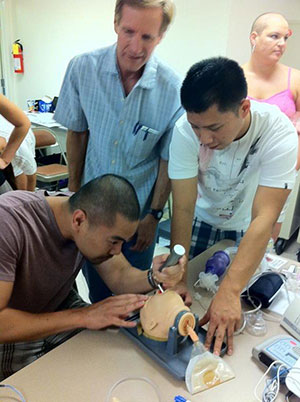PALS Study Guide
American Heart Association Healthcare Provider Authorized CoursePALS Certification
$180
PALS Recertification
$160
PALS Online & Skills
$170
The Pediatric Advanced Life Support (PALS) course teaches and reinforces knowledge and skills to best recognize and treat critically ill pediatric patients. The course uses a scenario-based, team approach and teaches emergency management of pediatric patients approaching or currently in respiratory/cardiac arrest.
PALS Study Guide
The below PALS Guidelines Summary is based on current AHA Guidelines, however, is not intended as a substitution for the Provider Manual
Chest Compressions
• A-B-C to C-A-B
• Circulation-Airway-Breathing
• quickly initiating chest compressions
• during CPR depress the infant sternum approximately 4 cm and the child sternum approximately 5 cm, allowing the chest to completely recoil (1/3 to 1/2 the A/P diameter)
• 100-120 compressions per minute
• one rescuer: 2 breaths: 30 compressions
• two rescuers: 2 breaths: 15 compressions
• give 10 breaths per minute or one breath every 6 seconds with advanced airway
• checking a pulse should require 5 seconds minimum, 10 seconds maximum
Quantitative Waveform Capnography
• recommended for confirmation and monitoring of ET tube placement
• provides a monitor of effective chest compressions
• CO2 detectors and capnography are for ET placement and to monitor CPR
• providers must always assess tracheal tube placement by using an ETCO2 detector as additional primary confirmation
Medication Protocols
• Amiodarone is now recommended for treatment of VF/pulseless VT
• intraosseous is now recommended for drug therapy, it can be used on all ages
• Lidocaine is now being deemphasized
Emergency Care Priorities
• The use of advanced airways, gaining vascular access, and administering drugs does not take priority over high-quality CPR and access to immediate defibrillation
• Endotracheal Tube may be used in infants and children using caution with cuff inflation pressure
• if the healthcare provider is not proficient to intubate
• AED
• Adult AED’s may now be used on children and infants if pediatric pads are not available • Defibrillation for VF or pulseless VT
• patients should be initially shocked with 2-4 J/kg
Comatose
• Maintain patient temperature between 32°C -34°C for 12-24 hours Post-cardiac Arrest Care
• O2 saturation
• maintain oxygen saturation between 94% and 99%
Shock
• Hypotension: consider 20 mL/kg IV/IO boluses of isotonic crystalloid over 5-20 minutes (consider over 5-10 minutes for severe, hypotensive, hypovolemic shock)
• Cardiogenic: consider 5-10 mL/kg IV/IO boluses of isotonic crystalloid over 10-20 minutes
• if poor cardiac function is suspected consider 10 mL/kg
• consider inotropic and/or vasopressor support for fluid-refractory shock
The authors make no claims of the accuracy of the information contained herein, and these suggested doses/interventions are not a substitute for clinical judgment. CPR 3G LLC is not liable for any special, consequential, or exemplary damages resulting in whole or part from any user’s use of or reliance upon this material. The information provided herein may or may not contain the most current guidelines. Refer to the AHA ECC Guidelines for more details and/or clarification in regards to the most current clinical guidelines.









